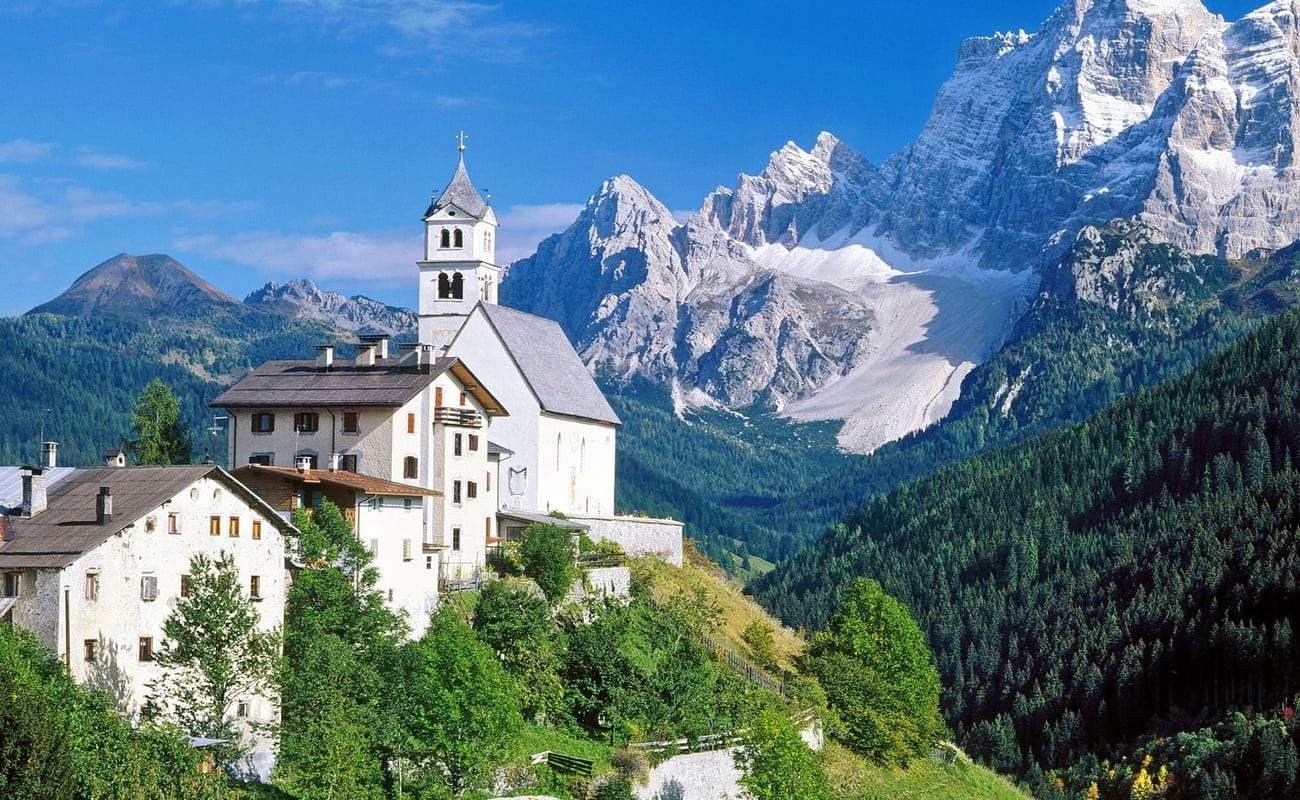 TravelINDIA.COM
TravelINDIA.COM
Dharamsala
home page
Dharamsala is located in the Kangra Valley, in the shadow of the Dhauladhar mountains.
Dharamshala also has beautiful tea gardens and its tea, known as Kangra tea, is very popular across India and the rest of the world.
Traditionally known for Kangra green tea, Dharamshala now produces all teas including black tea, green tea, oolong tea
and white teas, in addition to the popular Kashmiri Kahwa and Masala Chai. You can visit the tea gardens at Mann Tea
Estate owned by Dharmsala Tea Company, where they offer guided tours of the tea gardens, the tea factory and tea
tastings. Kangra green tea is considered to be amongst the best in India, and has also been found to have among the
highest anti-oxidant levels of all green teas produced in India.
Dharamshala is a municipal corporation city in the upper reaches of the Kangra Valley and is surrounded by dense coniferous
forest consisting mainly of stately Deodar cedar trees. The suburbs include McLeod Ganj, Bhagsunath, Dharamkot, Naddi,
ForsythGanj, Kotwali Bazaar (the main market), Kaccheri Adda (government offices such as the court, police, post, etc.), Dari, Ramnagar, Sidhpur, and Sidhbari (where the Karmapa is based).
This place is also famous for its newly built cricket stadium which offers opportunities to the youth of state to
prepare for their future in the game.
Dharamshala (also spelled Dharamsala) is the second winter capital of the Indian state of Himachal Pradesh and a
municipal corporation in Kangra district. It also serves as the district headquarters. It was formerly known as
Bhagsu. The Dalai Lama's residence and the headquarters of Central Tibetan Administration (the Tibetan government in
exile) are in Dharamshala. Dharamshala is 18 kilometers from Kangra.
history
Saint John’s Church in The Wilderness at Dharamsala, Built in 1852
In 1848, the area now known as Dharamshala was annexed by the British.
"Dharamsala lies on a spur of the Dhaola Dhar, 16 miles north-east of Kangra, in the midst of wild and picturesque scenery. It originally formed a subsidiary cantonment for the troops stationed at Kangra, and was first occupied as a station in 1849, when a site was required for a cantonment to accommodate a Native regiment which was being raised in the District. A site was found upon the slopes of the Dhaola Dhar, in a plot of waste land, upon which stood an old Hindu resthouse, or dharmsala, whence the name adopted for the new cantonment. The civil authorities, following the example of the regimental officers, and attracted by the advantages of climate and scenery, built themselves houses in the neighbourhood of the cantonment; and in 1855 the new station was formally recognised as the headquarters of the [Kangra] District."[9]
In 1860, the 66th Gurkha Light Infantry was moved from Kangra, Himachal Pradesh to Dharamshala, which was at first made a subsidiary cantonment. An ideal position for the new base was found on the slopes of the Dhauladhar Hills, near the site of a Hindu sanctuary, or Dharamshala, hence the name of the town.[10][11] The Battalion was later renamed the historic 1st Gurkha Rifles, this was the beginning of the legend of the Gurkhas, also known as the 'Bravest of the Brave'. Consequently, fourteen Gurkha platoon villages grew from this settlement, and exist to this day, namely Dari, Ramnagar, Shyamnagar, Dal, Totarani, Khanyara, Sadher, Chaandmaari, Sallagarhi, Sidhbari, Yol, and so on. The Gurkhas worshipped at the ancient Shiva temple of Bhagsunag. The Gurkhas referred to Dharamshala as 'Bhagsu' and referred to themselves as Bhagsuwalas.
The 21st Gurkha Regiment from Dharamshala performed heroic feats during World War I and the North West Frontier
Province campaigns. The Gurkha cantonment then reached its zenith during World War II, when battalions from
Dharamshala made history. Many place names in the town still retain their former cantonment terminologies: Depot
Bazaar, Pensioners' Lines, Tirah Lines (named after the 19th century Tirah Campaign), Bharatpore Lines
(named after the 1826 Battle of Bharatpore).
 The second Lord Elgin, Viceroy of India died here (at the 1st Gurkha Rifles Officers' Mess) in 1863 and is buried in the cemetery of St. John in the Wilderness, a small Anglicanchurch distinguished by its stained-glass windows. Dharamshala became a popular hill station for the British working in or near Delhi, offering a cool respite during the hot summer months.
"Before the earthquake of 1905, the upper part of the station, which rises to a height of 7,112 feet [2,168 metres], contained the European houses, the station church, and the officers' mess and lines of the 1st Gurkhas, together with the public gardens, post office, and two bazars, the Forsythganj and McLeodganj. The public offices, a bazar, and a few European houses made up the lower station, as low as 4,500 feet [1,372 metres]. The 1st battalion of the 1st Gurkhas used to be stationed here, but was moved to the upper station in 1894-5.... The public gardens, which were, before the earthquake, laid out with much taste in lawns and terraces, contained a valuable collection of indigenous and imported trees and shrubs, and were overlooked by the Assembly Rooms, a handsome building comprising a public hall, a library and reading-room and a billiard-room. The church was beautifully situated in a recess of the mountain."[12]
In 1905, the Kangra valley suffered a major earthquake. On 4 April of that year, the earth shook, demolishing much of the cantonment and the neighbouring city of Kangra, Himachal Pradesh as well as the Bhagsunag temple. Altogether, the 1905 Kangra earthquake killed 20,000 people. "1,625 persons perished at Dharamsala alone, including 15 Europeans and 112 of the Gurkha garrison."[13]
The Gurkhas rebuilt the town along with the temple, which today is acknowledged as the 1st Gurkha Rifles' heritage. The British had planned to make Dharamshala the summer capital of India, but moved to Shimla after the disaster.
Not only did the Gurkhas of Dharmshala make a major contribution to India's defence, many were freedom fighters for
the Indian National Army, which had been founded by Netaji Subhas Chandra Bose. The Indian National Army Captain Ram
Singh Thakur, a Gurkha from the village of Khanyara, composed some of India's most popular and stirring patriotic
songs, including "Kadam Kadam Badaye Ja". He is acknowledged so by the Netaji Research Bureau, Kolkata. The important
contribution of the noted Gurkha social commentator, the late Master Mitrasen Thapa, from the village of Totarani, has
been acknowledged by the Himachal Pradesh government. Recently, a park dedicated to the memory of the late Brigadier
Sher Jung Thapa, MVC, the 'Hero of Skardu', has been opened alongside the road between Lower and Upper Dharamshala.
The second Lord Elgin, Viceroy of India died here (at the 1st Gurkha Rifles Officers' Mess) in 1863 and is buried in the cemetery of St. John in the Wilderness, a small Anglicanchurch distinguished by its stained-glass windows. Dharamshala became a popular hill station for the British working in or near Delhi, offering a cool respite during the hot summer months.
"Before the earthquake of 1905, the upper part of the station, which rises to a height of 7,112 feet [2,168 metres], contained the European houses, the station church, and the officers' mess and lines of the 1st Gurkhas, together with the public gardens, post office, and two bazars, the Forsythganj and McLeodganj. The public offices, a bazar, and a few European houses made up the lower station, as low as 4,500 feet [1,372 metres]. The 1st battalion of the 1st Gurkhas used to be stationed here, but was moved to the upper station in 1894-5.... The public gardens, which were, before the earthquake, laid out with much taste in lawns and terraces, contained a valuable collection of indigenous and imported trees and shrubs, and were overlooked by the Assembly Rooms, a handsome building comprising a public hall, a library and reading-room and a billiard-room. The church was beautifully situated in a recess of the mountain."[12]
In 1905, the Kangra valley suffered a major earthquake. On 4 April of that year, the earth shook, demolishing much of the cantonment and the neighbouring city of Kangra, Himachal Pradesh as well as the Bhagsunag temple. Altogether, the 1905 Kangra earthquake killed 20,000 people. "1,625 persons perished at Dharamsala alone, including 15 Europeans and 112 of the Gurkha garrison."[13]
The Gurkhas rebuilt the town along with the temple, which today is acknowledged as the 1st Gurkha Rifles' heritage. The British had planned to make Dharamshala the summer capital of India, but moved to Shimla after the disaster.
Not only did the Gurkhas of Dharmshala make a major contribution to India's defence, many were freedom fighters for
the Indian National Army, which had been founded by Netaji Subhas Chandra Bose. The Indian National Army Captain Ram
Singh Thakur, a Gurkha from the village of Khanyara, composed some of India's most popular and stirring patriotic
songs, including "Kadam Kadam Badaye Ja". He is acknowledged so by the Netaji Research Bureau, Kolkata. The important
contribution of the noted Gurkha social commentator, the late Master Mitrasen Thapa, from the village of Totarani, has
been acknowledged by the Himachal Pradesh government. Recently, a park dedicated to the memory of the late Brigadier
Sher Jung Thapa, MVC, the 'Hero of Skardu', has been opened alongside the road between Lower and Upper Dharamshala.
Culture
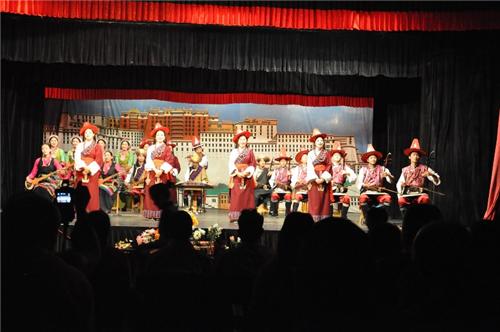
The culture of Dharamshala is very vibrant and closely linked with the religious practices followed by the people
of this city. The influences of the nomadic Gaddis, Hinduism and Buddhism can all be found in the traditions here.
With the coming of the Dalai Lama and the Tibetan government-in-exile, the culture and heritage of Tibet has also been
brought to this hill station, so much that it resembles Lhasa the capital of Tibet, from a cultural point of view.
Handicrafts and handmade garments, made in the Tibetan style, are in abundant supply in this city. The traditional
folk dances of India, linked with Hinduism, are performed in Dharamshala. The theatrical traditions of Tibet are also
preserved here, with performances of Tibetan opera accompanied by drums, dance and music, particular to Tibet.
Consequently, Dharamshala is quite famous for its authentic Tibetan cuisine. The people of this town celebrate many
festivals like the Haldi festival, Lohri Agricultural Festival, Losar Festival, International Himalayan Festival and
many more.
Tourism
Baijnath Shiv Temple:
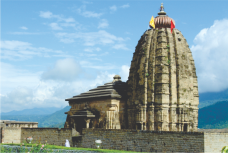 This particularly beautiful ancient Shiv temple at Baijnath is 16 Km from Palampur, on the Pathankot-Mandi national
highway. Built of stone in the 9th century AD in the shikhara style, it is a fine blend of sculpture and architecture.
The temple is easily accessible from both Palampur and Kangra. The linga enshrined in its sanctum is one of the 12
Jyotirlingas in the country. Every year during the Shivratri fair, pilgrims decend on Baijnath for the colourful fair
and festivities.
This particularly beautiful ancient Shiv temple at Baijnath is 16 Km from Palampur, on the Pathankot-Mandi national
highway. Built of stone in the 9th century AD in the shikhara style, it is a fine blend of sculpture and architecture.
The temple is easily accessible from both Palampur and Kangra. The linga enshrined in its sanctum is one of the 12
Jyotirlingas in the country. Every year during the Shivratri fair, pilgrims decend on Baijnath for the colourful fair
and festivities.
Kareri:
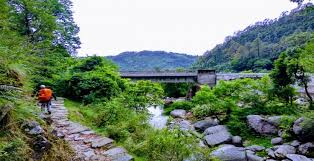 A 12 Km trek from Mcleodganj
passing through Dal lake, Satobari and Ghera leads to Kareri village. It overlooks the flat & fertile lands of Himachal
and Punjab, seems to stretch on to infinity. Kareri village has a picturesque forst rest house. 13 Km further is the
Kareri lake (3200 mtr) having beautiful high altitute meadows, extensive pasture lands and undulating slopes carpeted
with patch work of green floral patterns.
A 12 Km trek from Mcleodganj
passing through Dal lake, Satobari and Ghera leads to Kareri village. It overlooks the flat & fertile lands of Himachal
and Punjab, seems to stretch on to infinity. Kareri village has a picturesque forst rest house. 13 Km further is the
Kareri lake (3200 mtr) having beautiful high altitute meadows, extensive pasture lands and undulating slopes carpeted
with patch work of green floral patterns.
St. John's Church:
 This Church stands on the Gandhi Chowk approximately 2 Km. from the main bus stand of Dalhousie. This Church was the
first to be built after the town of Dalhousie was founded. Prior to 1863 a wooden structure stood at this place.
This Church stands on the Gandhi Chowk approximately 2 Km. from the main bus stand of Dalhousie. This Church was the
first to be built after the town of Dalhousie was founded. Prior to 1863 a wooden structure stood at this place.
Nurpur:
 Nurpur is famous for an old fort and a temple of Brij Raj. Nurpur acquired its name in 1672, when Jahangir, the Mughal Emperor named it after his wife Nurjahan. Built in the late 16th century by Raja Basu the Nurpur Fort is massive and sprawling. It spreads across a long flat plateau forming the western end of the ridge and bears signs of great architectural designs. The fort overlooks the Jabhar Khud, a tributary of the Chakki rivulet and the vast valley formed by it.
Nurpur is famous for an old fort and a temple of Brij Raj. Nurpur acquired its name in 1672, when Jahangir, the Mughal Emperor named it after his wife Nurjahan. Built in the late 16th century by Raja Basu the Nurpur Fort is massive and sprawling. It spreads across a long flat plateau forming the western end of the ridge and bears signs of great architectural designs. The fort overlooks the Jabhar Khud, a tributary of the Chakki rivulet and the vast valley formed by it.
Kotla Fort:
 Kotla Fort is another
heritage monument on the State Highway between Shahpur and Nurpur. Kotla fort stands on an isolated peak, impressively
looking around the deep valleys. The fort was built by the Guler Rajas. The road to the fort winds upwards and is not
too difficult; the climb going through the dense forest of pine is pleasant. At the main entrance is the Bagulamukhi
temple, one of the incarnations of Durga.
Kotla Fort is another
heritage monument on the State Highway between Shahpur and Nurpur. Kotla fort stands on an isolated peak, impressively
looking around the deep valleys. The fort was built by the Guler Rajas. The road to the fort winds upwards and is not
too difficult; the climb going through the dense forest of pine is pleasant. At the main entrance is the Bagulamukhi
temple, one of the incarnations of Durga.
Kunal Pathri:
 A level 3Km walk from Kotwali Bazar leads upto the rock temple of the local goddess Durga. In the temple there is stone which remains always wet. According to local belief, the moment it starts drying, it
A level 3Km walk from Kotwali Bazar leads upto the rock temple of the local goddess Durga. In the temple there is stone which remains always wet. According to local belief, the moment it starts drying, it
Transportation

By Road - Direct and regular
bus service from Delhi, Chandigarh, Jammu , Shimla , Chamba and Manali
 By Rail - Pathankot is the nearest broad gauge railway terminal to Dharamsala. From Pathankot there is a narrow gauge railway line up to Kangra (94 Km) and from here Dharamshala is 17 Km by road.
By Rail - Pathankot is the nearest broad gauge railway terminal to Dharamsala. From Pathankot there is a narrow gauge railway line up to Kangra (94 Km) and from here Dharamshala is 17 Km by road.
 By Air - Nearest airport is Gaggal.
By Air - Nearest airport is Gaggal.
Climate
Temperature: Max. 38 C in June; Min. 00 C in Jan.
Annual rainfall: Varies between 290 cm to 380 cm second highest rainfall in the country.
Best season: January to June; September to December. July-August is rainy season.
Clothing : Heavy woolens in winters and light woolens and tropical in summers
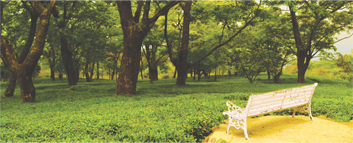
Food
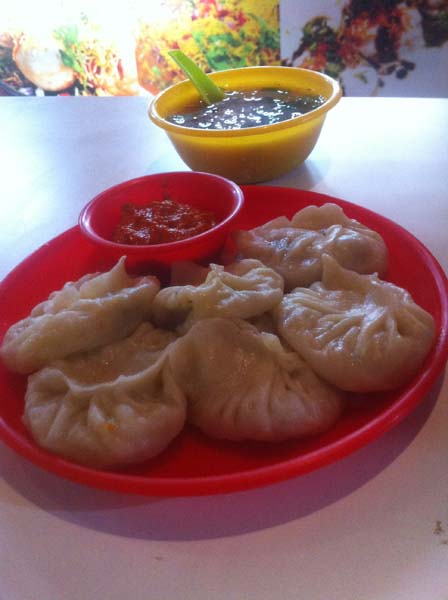
the oldest Tibetan shop in Mcleodganj, Dharamshala. It is known for the two food items it serves – Momos (both
steamed as well as fried) and Thupka. For an eatery serving only two items, this old shop draws huge crowds for its
fresh momos and flavourful thukpa. The Mutton momos are a must try here – they have a filling of minced mutton along
with local spices, onion and garlic – all the filling ingredients are grated and sautéed before being stuffed into the
momo jackets. The thupka gained popularity due to the extra soft noodles that are used in it. Freshly prepared,
steaming hot thupka is a perfect meal at any time of the day in this hilly town. Note: The noodles used in the thupka
are home made by the owner herself. Made of a mixture of refined flour and eggs, they are soft and fresh. Must try:
Momos.
 The second Lord Elgin, Viceroy of India died here (at the 1st Gurkha Rifles Officers' Mess) in 1863 and is buried in the cemetery of St. John in the Wilderness, a small Anglicanchurch distinguished by its stained-glass windows. Dharamshala became a popular hill station for the British working in or near Delhi, offering a cool respite during the hot summer months.
"Before the earthquake of 1905, the upper part of the station, which rises to a height of 7,112 feet [2,168 metres], contained the European houses, the station church, and the officers' mess and lines of the 1st Gurkhas, together with the public gardens, post office, and two bazars, the Forsythganj and McLeodganj. The public offices, a bazar, and a few European houses made up the lower station, as low as 4,500 feet [1,372 metres]. The 1st battalion of the 1st Gurkhas used to be stationed here, but was moved to the upper station in 1894-5.... The public gardens, which were, before the earthquake, laid out with much taste in lawns and terraces, contained a valuable collection of indigenous and imported trees and shrubs, and were overlooked by the Assembly Rooms, a handsome building comprising a public hall, a library and reading-room and a billiard-room. The church was beautifully situated in a recess of the mountain."[12]
In 1905, the Kangra valley suffered a major earthquake. On 4 April of that year, the earth shook, demolishing much of the cantonment and the neighbouring city of Kangra, Himachal Pradesh as well as the Bhagsunag temple. Altogether, the 1905 Kangra earthquake killed 20,000 people. "1,625 persons perished at Dharamsala alone, including 15 Europeans and 112 of the Gurkha garrison."[13]
The Gurkhas rebuilt the town along with the temple, which today is acknowledged as the 1st Gurkha Rifles' heritage. The British had planned to make Dharamshala the summer capital of India, but moved to Shimla after the disaster.
Not only did the Gurkhas of Dharmshala make a major contribution to India's defence, many were freedom fighters for
the Indian National Army, which had been founded by Netaji Subhas Chandra Bose. The Indian National Army Captain Ram
Singh Thakur, a Gurkha from the village of Khanyara, composed some of India's most popular and stirring patriotic
songs, including "Kadam Kadam Badaye Ja". He is acknowledged so by the Netaji Research Bureau, Kolkata. The important
contribution of the noted Gurkha social commentator, the late Master Mitrasen Thapa, from the village of Totarani, has
been acknowledged by the Himachal Pradesh government. Recently, a park dedicated to the memory of the late Brigadier
Sher Jung Thapa, MVC, the 'Hero of Skardu', has been opened alongside the road between Lower and Upper Dharamshala.
The second Lord Elgin, Viceroy of India died here (at the 1st Gurkha Rifles Officers' Mess) in 1863 and is buried in the cemetery of St. John in the Wilderness, a small Anglicanchurch distinguished by its stained-glass windows. Dharamshala became a popular hill station for the British working in or near Delhi, offering a cool respite during the hot summer months.
"Before the earthquake of 1905, the upper part of the station, which rises to a height of 7,112 feet [2,168 metres], contained the European houses, the station church, and the officers' mess and lines of the 1st Gurkhas, together with the public gardens, post office, and two bazars, the Forsythganj and McLeodganj. The public offices, a bazar, and a few European houses made up the lower station, as low as 4,500 feet [1,372 metres]. The 1st battalion of the 1st Gurkhas used to be stationed here, but was moved to the upper station in 1894-5.... The public gardens, which were, before the earthquake, laid out with much taste in lawns and terraces, contained a valuable collection of indigenous and imported trees and shrubs, and were overlooked by the Assembly Rooms, a handsome building comprising a public hall, a library and reading-room and a billiard-room. The church was beautifully situated in a recess of the mountain."[12]
In 1905, the Kangra valley suffered a major earthquake. On 4 April of that year, the earth shook, demolishing much of the cantonment and the neighbouring city of Kangra, Himachal Pradesh as well as the Bhagsunag temple. Altogether, the 1905 Kangra earthquake killed 20,000 people. "1,625 persons perished at Dharamsala alone, including 15 Europeans and 112 of the Gurkha garrison."[13]
The Gurkhas rebuilt the town along with the temple, which today is acknowledged as the 1st Gurkha Rifles' heritage. The British had planned to make Dharamshala the summer capital of India, but moved to Shimla after the disaster.
Not only did the Gurkhas of Dharmshala make a major contribution to India's defence, many were freedom fighters for
the Indian National Army, which had been founded by Netaji Subhas Chandra Bose. The Indian National Army Captain Ram
Singh Thakur, a Gurkha from the village of Khanyara, composed some of India's most popular and stirring patriotic
songs, including "Kadam Kadam Badaye Ja". He is acknowledged so by the Netaji Research Bureau, Kolkata. The important
contribution of the noted Gurkha social commentator, the late Master Mitrasen Thapa, from the village of Totarani, has
been acknowledged by the Himachal Pradesh government. Recently, a park dedicated to the memory of the late Brigadier
Sher Jung Thapa, MVC, the 'Hero of Skardu', has been opened alongside the road between Lower and Upper Dharamshala.

 This particularly beautiful ancient Shiv temple at Baijnath is 16 Km from Palampur, on the Pathankot-Mandi national
highway. Built of stone in the 9th century AD in the shikhara style, it is a fine blend of sculpture and architecture.
The temple is easily accessible from both Palampur and Kangra. The linga enshrined in its sanctum is one of the 12
Jyotirlingas in the country. Every year during the Shivratri fair, pilgrims decend on Baijnath for the colourful fair
and festivities.
This particularly beautiful ancient Shiv temple at Baijnath is 16 Km from Palampur, on the Pathankot-Mandi national
highway. Built of stone in the 9th century AD in the shikhara style, it is a fine blend of sculpture and architecture.
The temple is easily accessible from both Palampur and Kangra. The linga enshrined in its sanctum is one of the 12
Jyotirlingas in the country. Every year during the Shivratri fair, pilgrims decend on Baijnath for the colourful fair
and festivities.  A 12 Km trek from Mcleodganj
passing through Dal lake, Satobari and Ghera leads to Kareri village. It overlooks the flat & fertile lands of Himachal
and Punjab, seems to stretch on to infinity. Kareri village has a picturesque forst rest house. 13 Km further is the
Kareri lake (3200 mtr) having beautiful high altitute meadows, extensive pasture lands and undulating slopes carpeted
with patch work of green floral patterns.
A 12 Km trek from Mcleodganj
passing through Dal lake, Satobari and Ghera leads to Kareri village. It overlooks the flat & fertile lands of Himachal
and Punjab, seems to stretch on to infinity. Kareri village has a picturesque forst rest house. 13 Km further is the
Kareri lake (3200 mtr) having beautiful high altitute meadows, extensive pasture lands and undulating slopes carpeted
with patch work of green floral patterns. This Church stands on the Gandhi Chowk approximately 2 Km. from the main bus stand of Dalhousie. This Church was the
first to be built after the town of Dalhousie was founded. Prior to 1863 a wooden structure stood at this place.
This Church stands on the Gandhi Chowk approximately 2 Km. from the main bus stand of Dalhousie. This Church was the
first to be built after the town of Dalhousie was founded. Prior to 1863 a wooden structure stood at this place.
 Nurpur is famous for an old fort and a temple of Brij Raj. Nurpur acquired its name in 1672, when Jahangir, the Mughal Emperor named it after his wife Nurjahan. Built in the late 16th century by Raja Basu the Nurpur Fort is massive and sprawling. It spreads across a long flat plateau forming the western end of the ridge and bears signs of great architectural designs. The fort overlooks the Jabhar Khud, a tributary of the Chakki rivulet and the vast valley formed by it.
Nurpur is famous for an old fort and a temple of Brij Raj. Nurpur acquired its name in 1672, when Jahangir, the Mughal Emperor named it after his wife Nurjahan. Built in the late 16th century by Raja Basu the Nurpur Fort is massive and sprawling. It spreads across a long flat plateau forming the western end of the ridge and bears signs of great architectural designs. The fort overlooks the Jabhar Khud, a tributary of the Chakki rivulet and the vast valley formed by it.  Kotla Fort is another
heritage monument on the State Highway between Shahpur and Nurpur. Kotla fort stands on an isolated peak, impressively
looking around the deep valleys. The fort was built by the Guler Rajas. The road to the fort winds upwards and is not
too difficult; the climb going through the dense forest of pine is pleasant. At the main entrance is the Bagulamukhi
temple, one of the incarnations of Durga.
Kotla Fort is another
heritage monument on the State Highway between Shahpur and Nurpur. Kotla fort stands on an isolated peak, impressively
looking around the deep valleys. The fort was built by the Guler Rajas. The road to the fort winds upwards and is not
too difficult; the climb going through the dense forest of pine is pleasant. At the main entrance is the Bagulamukhi
temple, one of the incarnations of Durga.  A level 3Km walk from Kotwali Bazar leads upto the rock temple of the local goddess Durga. In the temple there is stone which remains always wet. According to local belief, the moment it starts drying, it
A level 3Km walk from Kotwali Bazar leads upto the rock temple of the local goddess Durga. In the temple there is stone which remains always wet. According to local belief, the moment it starts drying, it



